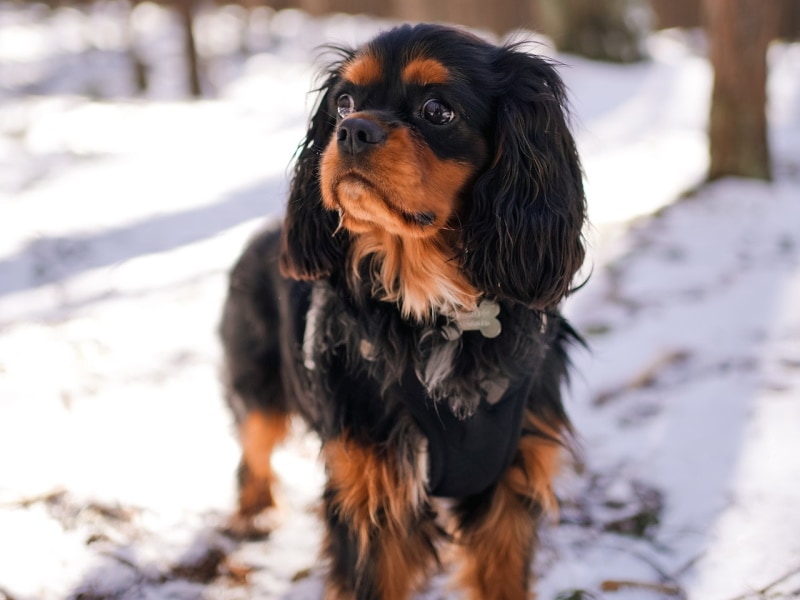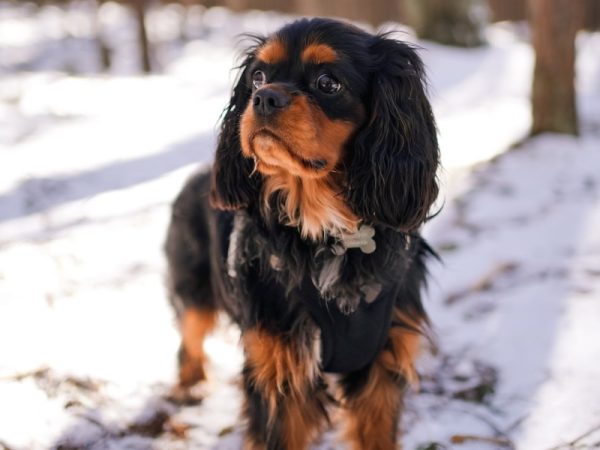Click to Skip Ahead
It’s hard not to fall in love with a Cavalier King Charles Spaniel when you first meet one. It’s an adorable dog with a sweet face that will melt your heart, guaranteed.
Breed Overview
Height:
12 – 13 inches
Weight:
13 – 18 pounds
Lifespan:
9 – 14 years
Colors:
Tricolor, “Blenheim,” Black and tan, ruby
Suitable for:
Families of all sorts
Temperament:
Affectionate, patient, people-oriented
The black and tan coat is one of four accepted colors by the American Kennel Club (AKC) and the United Kennel Club (UKC). It’s the same with the Fédération Cynologique Internationale (FCI), the global registry.
Cavalier King Charles Spaniel Characteristics
The Earliest Records of the Black and Tan Cavalier King Charles Spaniel in History
Humans first domesticated canines between 20,000 and 40,000 years ago. Once the relationship was established, people then selectively bred them for certain purposes. Great Britain is the dog’s country of origin. The Cavalier King Charles Spaniel has a unique history. We know of its early days from artists’ depictions of the breed in the 15th century.
Painters such as Van Dyck and Rembrandt made the breed the subject of many works. It’s easy to see why this pup would be an ideal choice. Its expressive face adds an emotional impact to a painting that is irresistible. That also explains their attraction to the British royalty, particularly with King Charles I and his son Charles II. A dog couldn’t have a better introduction.
How the Black and Tan Cavalier King Charles Spaniel Gained Popularity
Selective breeding played a role in altering the appearance of the Cavalier King Charles Spaniel into the 18th century. Interestingly, the various color variations coincided with different monarchs. That explains the name of the black and tan with its association with King Charles. This royal connection isn’t unusual, then or now. Pembroke Welsh Corgis were a favorite of the late Queen Elizabeth II.
Undoubtedly, the nobility had an influence on the breed’s popularity, particularly with popular monarchs. Famous fanciers include Michael Jackson, Tom Selleck, Keith Richards, and the late President Ronald Reagan. We understand the attraction and how it probably ensured the Cavalier King Charles Spaniel’s place in history. It is the AKC’s 17th most popular breed.

Formal Recognition of the Black and Tan Cavalier King Charles Spaniel
We mentioned the unique history of this breed. While it is a relatively old breed, the AKC didn’t recognize it formally until 1995. The FCI was on board in 1955. One reason for the delay in the United States was the changes resulting from selective breeding. Some pups didn’t resemble the subjects of the artists’ paintings. Enthusiast Roswell Eldridge changed it in the 1920s.
The Cavalier King Charles Spaniel had a revival. However, it wasn’t until 1952 before the pup made it stateside. The formation of the official club and eventual official status followed. It’s worth noting that this time was challenging for many enthusiasts to bring European dogs overseas because of World War II. However, one must admire the dedication of these people to save various breeds.
Top 5 Unique Facts About the Black and Tan Cavalier King Charles Spaniel
1. Meanness is not tolerated with the AKC breed standard
We liked that AKC recognizes one of the best things about this breed: its lovable nature. Seriously, these dogs are major lovers. So, why not get one for yourself?
2. The Cavalier King Charles Spaniel excels as a therapy dog
Who wouldn’t feel better with this pup at your side, making everything all right? Even though AKC considers it a toy breed, we can see it as one of the best companions and therapy dogs ever!

The short muzzle of these breeds is an integral part of their charm. The interesting thing is that the former influenced the looks of the latter, which played a role in its popularity.
4. The Cavalier King Charles Spaniel is the AKC’s 140th recognized breed
This pup reached a milestone when it became the organization’s 140th recognized breed. Our only question is, why did it take so long?

5. The Cavalier King Charles Spaniel doesn’t snore
While not everyone lets their pets sleep in bed with them, you won’t be sorry if you invite the Cavalier King Charles Spaniel to snuggle with you at night. It won’t keep you awake with its snoring, like some other dog breeds.
Does the Black and Tan Cavalier King Charles Spaniel Make a Good Pet?
The Cavalier King Charles Spaniel has a lot going for it. It’s an adaptable pup that can handle city life just fine. It’s an affectionate dog, whether you’re talking about adults, children, or other canines. A stranger is a friend that this pooch hasn’t met. It’s an intelligent pup that is easy to train. We recommend limiting the treats to lesson time because of the breed’s propensity for obesity.
This dog doesn’t have a strong wanderlust potential. It knows a good thing when it’s got it, so it sticks close to the home fire. The Cavalier King Charles Spaniel is moderately active, although it is very playful. We strongly urge you to get a puppy from a reputable seller who does the recommended pre-breeding testing. Unsurprisingly, some congenital issues are prevalent.
Conclusion
The Cavalier King Charles Spaniel is an adorable pup. You don’t have to take the word of celebrities or famous painters to prove it. It’s an affectionate dog that is relatively easy to train. While it loves kids, it is also content to cuddle on the sofa after a rousing playing session. First-time pet owners couldn’t ask for a better breed to invite into their homes.
Featured Image Credit: Katrīne Žuka, Pexels











